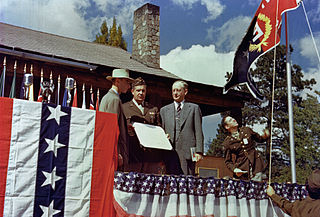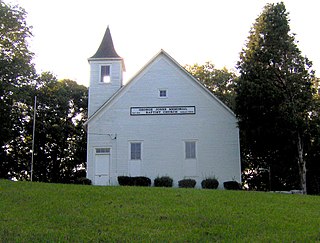
Elza was a community in Anderson County, Tennessee, that existed before 1942, when the area was acquired for the Manhattan Project. Its site is now part of the city of Oak Ridge, Tennessee.

Elza was a community in Anderson County, Tennessee, that existed before 1942, when the area was acquired for the Manhattan Project. Its site is now part of the city of Oak Ridge, Tennessee.
Elza formed around a flagstop on the Louisville and Nashville Railroad. The community had a country store but no post office, instead receiving mail through the nearby community of Dossett. [1] The community's name was derived from the surname of a railroad construction engineer named Paul Elza. Construction materials for a bridge over the Clinch River and an underpass near Dossett were marked "Elza" and were delivered to a shed near the railroad tracks. [1]
William "Fiddlin' Bill" Sievers, an early country music guitarist and member of the Tennessee Ramblers band, was born in the Elza area in 1875. [2]
When the federal government evaluated sites for the Manhattan Project facilities that ultimately were sited at Oak Ridge, the Oak Ridge site was described in internal memos as "near Elza." [3] During World War II, Elza was the site of one of the security gates on the borders of the closed city of Oak Ridge. Located on the road from Clinton to Oak Ridge, the Elza gate was "the busiest and most public" of Oak Ridge's entrance gates. [1] When the Oak Ridge townsite was first opened to outsiders in 1949, the gate-opening ceremony was conducted at the Elza gate. [1]
The Luther Brannon House, built in 1941 and razed in 2021, was a surviving structure associated with the Elza community. [4] During World War II and for some time thereafter, the Manhattan Engineer District and the U.S. Atomic Energy Commission used several warehouses in the Elza area for storage of uranium ore and other materials. In the early 1990s, the U.S. Department of Energy cleaned up the site, where soil had been found to be contaminated by PCBs and uranium. [5]

The Manhattan Project was a research and development program undertaken during World War II to produce the first nuclear weapons. It was led by the United States in collaboration with the United Kingdom and Canada. From 1942 to 1946, the project was directed by Major General Leslie Groves of the U.S. Army Corps of Engineers. Nuclear physicist J. Robert Oppenheimer was the director of the Los Alamos Laboratory that designed the bombs. The Army program was designated the Manhattan District, as its first headquarters were in Manhattan; the name gradually superseded the official codename, Development of Substitute Materials, for the entire project. The project absorbed its earlier British counterpart, Tube Alloys. The Manhattan Project employed nearly 130,000 people at its peak and cost nearly US$2 billion, over 80 percent of which was for building and operating the plants that produced the fissile material. Research and production took place at more than 30 sites across the US, the UK, and Canada.

Oak Ridge is a city in Anderson and Roane counties in the eastern part of the U.S. state of Tennessee, about 25 miles (40 km) west of downtown Knoxville. Oak Ridge's population was 31,402 at the 2020 census. It is part of the Knoxville Metropolitan Area. Oak Ridge's nicknames include the Atomic City, the Secret City, and the City Behind a Fence.

A calutron is a mass spectrometer originally designed and used for separating the isotopes of uranium. It was developed by Ernest Lawrence during the Manhattan Project and was based on his earlier invention, the cyclotron. Its name was derived from California University Cyclotron, in tribute to Lawrence's institution, the University of California, where it was invented. Calutrons were used in the industrial-scale Y-12 uranium enrichment plant at the Clinton Engineer Works in Oak Ridge, Tennessee. The enriched uranium produced was used in the Little Boy atomic bomb that was detonated over Hiroshima on 6 August 1945.

K-25 was the codename given by the Manhattan Project to the program to produce enriched uranium for atomic bombs using the gaseous diffusion method. Originally the codename for the product, over time it came to refer to the project, the production facility located at the Clinton Engineer Works in Oak Ridge, Tennessee, the main gaseous diffusion building, and ultimately the site. When it was built in 1944, the four-story K-25 gaseous diffusion plant was the world's largest building, comprising over 5,264,000 square feet (489,000 m2) of floor space and a volume of 97,500,000 cubic feet (2,760,000 m3).

The Y-12 National Security Complex is a United States Department of Energy National Nuclear Security Administration facility located in Oak Ridge, Tennessee, near the Oak Ridge National Laboratory. It was built as part of the Manhattan Project for the purpose of enriching uranium for the first atomic bombs. In the years after World War II, it has been operated as a manufacturing facility for nuclear weapons components.

The Manhattan Project was a research and development project that produced the first atomic bombs during World War II. It was led by the United States with the support of the United Kingdom and Canada. From 1942 to 1946, the project was under the direction of Major General Leslie Groves of the US Army Corps of Engineers. The Army component of the project was designated the Manhattan District; "Manhattan" gradually became the codename for the entire project. Along the way, the project absorbed its earlier British counterpart, Tube Alloys. The Manhattan Project began modestly in 1939, but grew to employ more than 130,000 people and cost nearly US$2 billion. Over 90% of the cost was for building factories and producing the fissionable materials, with less than 10% for development and production of the weapons.

The S-50 Project was the Manhattan Project's effort to produce enriched uranium by liquid thermal diffusion during World War II. It was one of three technologies for uranium enrichment pursued by the Manhattan Project.
Oak Ridge High School is the public high school for Oak Ridge, Tennessee, enrolling grades 9 through 12. It was established in 1943 to educate the children of Manhattan Project workers.

Site A was a research facility near Chicago where, during World War II, research on behalf of the Manhattan Project was carried out. Operated by the University of Chicago's Metallurgical Laboratory, it was the site of Chicago Pile-2, a reconstructed and enlarged version of the world's first nuclear reactor, Chicago Pile-1. The first heavy-water reactor, Chicago Pile-3, was also constructed at this site. Research was carried out under contract to the United States' Office of Scientific Research and Development. After the war, the site became the first home of Argonne National Laboratory, a federally funded research and development center.

The X-10 Graphite Reactor is a decommissioned nuclear reactor at Oak Ridge National Laboratory in Oak Ridge, Tennessee. Formerly known as the Clinton Pile and X-10 Pile, it was the world's second artificial nuclear reactor and the first designed and built for continuous operation. It was built during World War II as part of the Manhattan Project.

Douglas Dam is a hydroelectric dam on the French Broad River in Sevier County, Tennessee, in the southeastern United States. The dam is operated by the Tennessee Valley Authority (TVA), which built the dam in record time in the early 1940s to meet emergency energy demands at the height of World War II. Douglas Dam is a straight reinforced concrete gravity-type dam 1705 feet long and 202 feet high, impounding the 28,420-acre (11,500 ha) Douglas Lake. The dam was named for Douglas Bluff, a cliff overlooking the dam site prior to construction.
Robertsville was a farming community in Anderson County, Tennessee, that was disbanded in 1942 when the area was acquired for the Manhattan Project. Its site is now part of the city of Oak Ridge, Tennessee.

Wheat was a farming community in Roane County, Tennessee. The area is now in the city of Oak Ridge.

Kenneth David Nichols CBE was an officer in the United States Army, and a civil engineer who worked on the secret Manhattan Project, which developed the atomic bomb during World War II. He served as Deputy District Engineer to James C. Marshall, and from 13 August 1943 as the District Engineer of the Manhattan Engineer District. Nichols led both the uranium production facility at the Clinton Engineer Works at Oak Ridge, Tennessee, and the plutonium production facility at Hanford Engineer Works in Washington state.

The three Oak Ridge gatehouses, also known as "checking stations", "guard houses", or "guard shacks", are security checkpoints in Oak Ridge, Tennessee, built c. 1948-1949 to control access to the Atomic Energy Commission (AEC) production and research facilities in Oak Ridge. These are individually listed on the U.S. National Register of Historic Places as Bear Creek Road Checking Station, Bethel Valley Road Checking Station and Oak Ridge Turnpike Checking Station.

The George Jones Memorial Baptist Church, also known as the "Wheat Church," is a historic church building at the former site of the community of Wheat in Oak Ridge, Tennessee, United States. It is the only structure remaining from Wheat, a rural Roane County community that was dissolved in 1942 when the United States government assumed ownership of the land for the Manhattan Project.

New Bethel Baptist Church is a historic church on Bethel Valley Road in Oak Ridge, Tennessee.

James Edward Westcott was an American photographer who was noted for his work with the United States government in Oak Ridge, Tennessee, during the Manhattan Project and the Cold War.

The Clinton Engineer Works (CEW) was the production installation of the Manhattan Project that during World War II produced the enriched uranium used in the 1945 bombing of Hiroshima, as well as the first examples of reactor-produced plutonium. It consisted of production facilities arranged at three major sites, various utilities including a power plant, and the town of Oak Ridge. It was in East Tennessee, about 18 miles (29 km) west of Knoxville, and was named after the town of Clinton, eight miles (13 km) to the north. The production facilities were mainly in Roane County, and the northern part of the site was in Anderson County. The Manhattan District Engineer, Kenneth Nichols, moved the Manhattan District headquarters from Manhattan to Oak Ridge in August 1943. During the war, CEW's advanced research was managed for the government by the University of Chicago.

The J. B. Jones House in Oak Ridge, Tennessee, United States, is a farmhouse that is listed on the National Register of Historic Places as one of the very small number of pre-Manhattan Project residences remaining in the city.